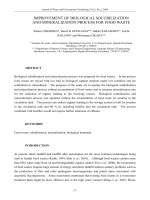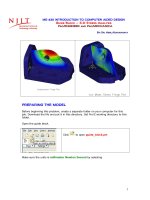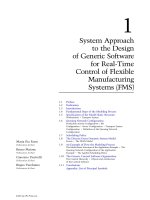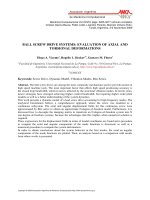LECTURE 7: CONTINUOUS DISTRIBUTIONS AND POISSON PROCESS docx
Bạn đang xem bản rút gọn của tài liệu. Xem và tải ngay bản đầy đủ của tài liệu tại đây (306.63 KB, 22 trang )
Probability in Computing
© 2010, Quoc Le & Van Nguyen
Probability for Computing 1
LECTURE 7: CONTINUOUS DISTRIBUTIONS AND
POISSON PROCESS
Agenda
Continuous random variables.
Uniform distribution
Exponential distribution
© 2010, Quoc Le & Van Nguyen
Probability for Computing 2
Poisson process
Queuing theory
Continuous Random Variables
Consider a roulette wheel which has circumference 1. We spin
the wheel, and when it stops, the outcome is the clockwise
distance X from the “0” mark to the arrow.
Sample space Ω consists of all real numbers in [0, 1).
Assume that any point on the circumference is equally likely to
© 2010, Quoc Le & Van Nguyen
Probability for Computing 3
Assume that any point on the circumference is equally likely to
face the arrow when the wheel stops. What’s the probability of
a given outcome x?
Note: In an infinite sample space there maybe possible events
that have probability = 0.
Recall that the distribution function F(x) = Pr(X ≤ x). and f(x) =
F’(x) then f(x) is called the density function of F(x).
Continuous Random Variables
f(x)dx = probability of the infinitesimal interval
[x, x + dx).
Pr(a ≤X<b) =
b
dx
x
f
)
(
© 2010, Quoc Le & Van Nguyen
Probability for Computing 4
Pr(a ≤X<b) =
E[X] =
E[g(X)] =
a
dx
x
f
)
(
dxxfxg )()(
dxxxf )(
Joint Distributions
Def: The joint distribution function of X and Y is F(x,y) = Pr(X ≤ x, Y
≤ y). = where f is the joint density function.
f(x, y) =
y x
dudvvuf ),(
),(
2
yxF
yx
© 2010, Quoc Le & Van Nguyen
Probability for Computing 5
Marginal distribution functions F
X
(x)=Pr(X ≤x) and F
Y
(y)=Pr(Y ≤y).
Example: F(x,y) = 1- e
-ax
– e
-by
+ e
-(ax+by)
, x, y >= 0.
F
X
(x)=F(x,∞) = 1-e
-ax
.
F
Y
(y)=1-e
-by
.
Since F
X
(x)F
Y
(y) = F(x, y) X and Y are independent.
Conditional Probability
What is Pr(X≤3|Y=4)? – Both numerator and
denominator = 0.
Rewriting Pr(X≤3|Y=4)? =
)
4
4
|
3
Pr(
lim
Y
X
© 2010, Quoc Le & Van Nguyen
Probability for Computing 6
Rewriting Pr(X≤3|Y=4)? =
Pr(X≤x|Y=y) =
)
4
4
|
3
Pr(
lim
0
Y
X
x
u
Y
du
yf
yuf
)(
),(
Uniform Distribution
Used to model random variables that tend to occur “evenly” over a
range of values
Probability of any interval of values proportional to its width
Used to generate (simulate) random variables from virtually any
distribution
© 2010, Quoc Le & Van Nguyen
Probability for Computing 7
Used to generate (simulate) random variables from virtually any
distribution
Used as “non-informative prior” in many Bayesian analyses
elsewhere 0
1
)(
bya
ab
yf
by
bya
ab
ay
ay
yF
1
0
)(
Uniform Distribution - expectation
)(3
))((
)(33
11
2)(2
))((
)(22
11
)(
2
2
22333
22
222
ab
abbaab
ab
aby
ab
dy
ab
yYE
ab
ab
abab
ab
aby
ab
dy
ab
yYE
b
a
b
a
b
a
b
a
© 2010, Quoc Le & Van Nguyen
Probability for Computing 8
)(2887.0
12
12
)(
12
)(
12
2
12
)2(3)(4
23
)(
)()(
3
)(
2
2222222
2
22
2
2
2
2
ab
abab
ababbaabababba
ababba
YEYEYV
abba
Additional Properties
Lemma 1: Let X be a uniform random variable on
[a, b]. Then, for c ≤ d, Pr(X ≤c|X ≤d)= (c-a)/(d-
a).
That is, conditioned on the fact that X ≤d, X is
uniform on [a, d].
© 2010, Quoc Le & Van Nguyen
Probability for Computing 9
uniform on [a, d].
Lemma 2: Let X
1
, X
2
, …, X
n
be independent
uniform random variables over [0, 1], Let Y
1
, Y
2
,
…, Y
n
be the same values as X
1
, X
2
, …, X
n
in
increasing sorted order. Then E[Y
k
] = k/(n+1).
Exponential Distribution
Right-Skewed distribution with maximum at
y
=0
Random variable can only take on positive values
Used to model inter-arrival times/distances for a
Poisson process
© 2010, Quoc Le & Van Nguyen
Probability for Computing 10
Poisson process
Additional Properties
Lemma 3: Pr(X>s+t|X>t) = Pr(X>s)
The exponential distribution is the only continuous memory-less
distribution: time until the 1
st
event in a memoryless continuous time
stochastic process.
Similarly, geometric is the only discrete memoryless distribution: time
until 1st success in a sequence of independent identical Bernoulli trials.
© 2010, Quoc Le & Van Nguyen
Probability for Computing 11
until 1st success in a sequence of independent identical Bernoulli trials.
Reliability: Amount of time a component has been in
service has no effect on the amount of time until it fails
Inter-event times: Amount of time since the last event
contains no information about the amount of time until the
next event
Service times: Amount of remaining service time is
independent of the amount of service time elapsed so far
Additional Properties
The minimum of several exponential random variables also exhibits
some interesting properties.
© 2010, Quoc Le & Van Nguyen
Probability for Computing 12
Example: An airline ticket counter has n service agents, where the time
that agent I takes per customer has an exponential distribution with
parameter
θ. You stand at the head of the line at time To, and all of
the n agents are busy. What is the average time you wait for an agent?
Because service time is exponentially distributed the remaining time for each customer is
still exponentially distributed.
Apply Lemma 8.5, time until 1
st
agent is free is exponentially distributed with parameter
∑θ
i
. expected time = 1 / ∑θ
i
.
The j
th
agent will become free first with prob. θ
j
/ ∑θ
i
.
Counting Process
A stochastic process {
N
(
t
),
t
0} is a
counting process
if
N
(
t
) represents the total number of events that have
occurred in [0,
t
]
© 2010, Quoc Le & Van Nguyen
Probability for Computing 13
13
Then {
N
(
t
),
t
0 } must satisfy:
a)
N
(
t
) 0
b)
N
(
t
) is an integer for all
t
c) If
s
<
t
, then
N
(
s
)
N
(
t
) and
d) For
s
<
t
,
N
(
t
) -
N
(
s
) is the number of events
that occur in the interval (
s
,
t
].
Stationary & Independent Increments
independent increments
A counting process has independent increments if
for any 0 s t u v,
N(t) – N(s) is independent of N(v) – N(u)
i.e., the numbers of events that occur in non
-
overlapping
© 2010, Quoc Le & Van Nguyen
Probability for Computing 14
14
stationary increments
A counting process has stationary increments if the
distribution if, for any s < t, the distribution of
N(t) – N(s)
depends only on the length of the time interval, t – s.
i.e., the numbers of events that occur in non
-
overlapping
intervals are independent r.v.s
Poisson Process Definition 1
A counting process {
N
(
t
),
t
0} is a
Poisson process with
rate l
,
l
> 0, if
N
(0) = 0
The process has independent increments
The number of events in any interval of length
t
© 2010, Quoc Le & Van Nguyen
Probability for Computing 15
15
The number of events in any interval of length
t
follows a Poisson distribution with mean t
Pr{ N(t+s) – N(s) = n } = (t)
n
e
–t
/n! , n = 0, 1, . . .
Where is arrival rate and t is length of the interval
Notice, it has stationary increments
Poisson Process Definition 2
© 2010, Quoc Le & Van Nguyen
Probability for Computing 16
Inter-Arrival and Waiting Times
The times between arrivals
T
1,
T
2, … are independent
exponential random variables with mean 1/
:
P(T1>t) = P(N(t) =0) =
e
-t
© 2010, Quoc Le & Van Nguyen
Probability for Computing 17
17
1
n
n i
i
S T
The (total) waiting time until the n
th
event has a gamma
distribution
1
n
n i
i
S T
An Example
Suppose that you arrive at a single teller bank to find five
other customers in the bank. One being served and the
other four waiting in line. You join the end of the line.
If the service time are all exponential with rate 5 minutes.
© 2010, Quoc Le & Van Nguyen
Probability for Computing 18
18
What is the prob. that you will be served in 10 minutes ?
What is the prob. that you will be served in 20 minutes ?
What is the expected waiting time before you are served?
Queuing Theory
Many applications:
In OS: Schedulers hold tasks in queue until required resources are
available.
In parallel/distributed processing: threads can queue for a critical
section that allows access to only one thread at a time.
In networks: packets are queued while waiting to be forwarded by
© 2010, Quoc Le & Van Nguyen
Probability for Computing 19
In networks: packets are queued while waiting to be forwarded by
a router.
We are going to:
Analyze one of the most basic queue model.
It uses Poisson process to model how customers arrive
Exponentially distributed r.v. to model the time required for
service.
Notations
Typical performance characteristics of queuing
models are:
© 2010, Quoc Le & Van Nguyen
Probability for Computing 20
L : Ave. number of customers in the system
L
Q
: Ave. number of customers waiting in queue
W : Ave. time customer spends in the system
W
Q
: Ave. time customer spends waiting in the queue
Queue notation
M/M/k/c
© 2010, Quoc Le & Van Nguyen
Probability for Computing 21
Arrival process
M = Markovian
GI = General
Departure process
(Service time distribution)
M = Markovian
G = General
Number of servers
Capacity of the queue
If nothing is specified,
we assume infinite capacity
M/M/1 queue
.israteserviceand
isratearrival whereprocess,Death -BirthSpecial
n
© 2010, Quoc Le & Van Nguyen
Probability for Computing 22
2
0
0
][
1
,
1,1 ,1
QQQ
n
n
n
WLSEWW
L
WnPL
nPP









